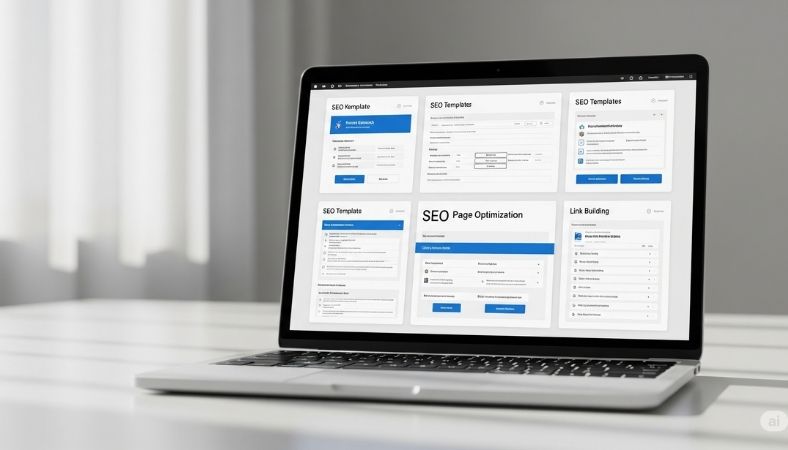Introduction
Hey there! Want to crank out killer blog posts without starting from scratch? SEO content templates are your new best friend. They’re like a recipe for cooking up search-friendly content. The Skyscraper technique is a smart SEO strategy. It involves finding top-performing content and making it better.
No more staring at a blank page. I’m gonna show you how these templates work, how to use them, and why they’re awesome. You’ll learn to create posts that rank high and pull traffic. By the end, you’ll have a game plan to dominate Google. Ready to make content creation a breeze? Let’s jump in!

What Are SEO Content Templates?
SEO content templates are pre-made frameworks for blog posts. They guide your writing to hit SEO goals. Think of them as blueprints for success. They include sections like intros, headings, and key points. You just fill in the details. SEO content templates ensure your post is structured right. They help you target keywords and user needs. Your content ranks better and feels polished. It’s like having a cheat sheet for SEO.
Why Are They Important?
Templates save you tons of time. They keep your content organized and focused. Readers love clear, easy-to-follow posts. Search engines do, too—they reward structure. SEO content templates align with what people search. They make sure you answer their questions. You’ll see more clicks and higher rankings. Plus, they streamline your workflow. You write faster and smarter. It’s a win for any content creator.
Key Features of Great Templates
What makes SEO content templates shine? They’re clear, flexible, and user-focused. They include spots for keywords and headings. You get sections for intros, tips, or FAQs. They’re built for your niche or audience. Good templates avoid fluff and keep you on track. They plan for visuals or examples. SEO content templates make writing feel effortless. They set you up for content that slays.
Step-by-Step Guide to Using SEO Content Templates
Ready to rock SEO content templates? These steps will help you create posts that shine. Let’s break it down.
Step 1: Pick the Right Template
Choose a template that fits your goal. Blog post, guide, or listicle? Pick one for your niche. For example, a “how-to” template works for tutorials. Check sites like HubSpot for free templates. Make sure it has clear sections. It should include an intro, a body, and a conclusion. A good template saves planning time. You just plug in your ideas. Start with something simple and proven.
Step 2: Research Your Keywords
Keywords drive your content’s success. Use tools like Google Keyword Planner or Ubersuggest. Find high-volume, low-competition phrases. Long-tail keywords, like “SEO content templates guide,” are best. They’re specific and rank easier. Match keywords to what users search. Use your main keyword, SEO content templates, seven times. Spread it naturally in your post. This keeps Google happy and drives traffic.
Step 3: Know Your Audience
Figure out who’s reading your stuff. Are they beginners or experts? Check their pain points on Reddit or Quora. Use AnswerThePublic for search questions. Your template should address their needs. Plan to answer specific problems or goals. This makes your content super relevant. Readers stick around when you solve issues. That boosts your SEO performance. Know your crowd inside out.
Step 4: Fill in the Template
Start filling your template with ideas. Write a catchy intro to hook readers. Add main points under H2 headings. Use H3 for subtopics or details. Include stats, examples, or stories. Keep sentences short and lively. Active voice makes it pop. SEO content templates guide your flow. Don’t stray too far from the structure. This ensures your post stays focused.
Step 5: Optimize for Search Engines
Make your content Google-friendly. Use your keyword, SEO content templates, in the title, headings. Add it to the meta description. Include alt text for images. Link to other posts on your site. Point to credible external sources. Ensure your page loads fast. Mobile-friendliness is non-negotiable. Plan for featured snippets with clear answers. This maximizes your ranking potential.
Step 6: Add Engaging Elements
Great content keeps readers glued. Plan for visuals like charts or infographics. Add a story or real-life example. Include calls to action, like “share this post.” Your template should have spots for these. Think about FAQs or tips sections. Engaging content lowers bounce rates. That’s a big SEO win. SEO content templates make this easy. You just follow the plan.
Step 7: Review and Polish
Before publishing, check your work. Does the template flow smoothly? Are all sections filled out? Look for gaps or fluff. Ensure keywords feel natural, not forced. Read it like a reader would. Tweak for clarity or punch. A polished post ranks better. SEO content templates help you spot issues. You’ll end up with a pro-level article.
Step 8: Promote Your Content
Publishing isn’t the finish line. Share your post on social media. Email it to your subscribers. Post in relevant groups or forums. Reach out to bloggers for backlinks. Use tools like Mailshake for outreach. Promotion gets eyes on your content. More shares mean more traffic. SEO content templates set you up for success. Now spread the word.
Advantages of SEO Content Templates
SEO content templates bring some serious perks. Let’s dive into why they’re a game-changer.
Saves You Time
Templates cut your planning time. You skip the “where do I start?” phase. Just follow the structure and write. They keep you focused, no wandering. You’ll churn out posts faster. This is gold for busy bloggers. SEO content templates streamline your process. You’ll feel like a content machine.
Boosts Content Consistency
Templates keep your posts uniform. Every article has a clear intro, body, conclusion. Readers know what to expect. Consistency builds trust and loyalty. Search engines love predictable structure. Your rankings get a boost. Templates make every post look pro. You’ll nail quality every time.
Improves SEO Performance
A good template is built for SEO. It ensures keywords are placed right. Headings and links are planned out. You’re more likely to rank high. Templates help you hit user intent. They make content easy for Google to crawl. Your posts climb search results. SEO content templates are your SEO shortcut.
Makes Writing Easier
No more writer’s block. Templates give you a clear path. You just fill in the blanks. They guide your ideas naturally. Even newbies can write like pros. Templates reduce stress and guesswork. You focus on creativity, not structure. Your content comes out polished.
Disadvantages of SEO Content Templates
Templates aren’t perfect, let’s be real. They have some downsides. Here’s what to watch out for.
Can Feel Restrictive
Templates might box you in. You could stick too closely to the format. This limits creative or unique ideas. Some posts need a freer vibe. Templates work best with flexibility. Otherwise, your content feels robotic. Balance structure with a bit of flair.
Takes Setup Time
Finding or creating templates isn’t instant. You need to pick the right one. Customizing it takes effort, too. Researching sections or keywords adds time. If you’re in a hurry, it feels slow. But once set, templates save hours. The upfront work is the catch.
May Not Fit All Content
Templates shine for standard posts. Odd formats, like creative stories, don’t always fit. A rigid template can feel forced. Short posts might not need one. You could waste time overplanning. Use templates for structured, long-form content. That’s where they excel.
Risk of Generic Content
If everyone uses similar templates, posts look alike. Your content might not stand out. Readers notice repetitive formats. Search engines might, too. You need unique angles or style. Templates are a guide, not gospel. Add your own spin to shine.
FAQs About SEO Content Templates
What Are SEO Content Templates?
They’re pre-made frameworks for blog posts. They guide structure and SEO for easy writing.
Do I Need a Template Always?
Not always, but they help. Use them for complex or SEO-focused posts.
How Long to Make One?
About 1-2 hours to pick or customize. It depends on your topic.
Can Beginners Use Templates?
Yes, they’re perfect for newbies. Templates make writing clear and professional.
How Do I Optimize Templates?
Use keywords like SEO content templates naturally. Plan headings, links, and fast pages.
Are Templates Worth It?
Totally they save time and boost rankings. Your content performs better consistently.
Bonus Points: Pro Tips for SEO Content Templates
Want to make your templates next-level? Try these tricks. Use niche-specific templates for a better fit. Add long-tail keywords for easier rankings. Plan for a content hub with linked posts. Include reader questions from social media. Use schema markup for SEO clarity. Add spots for interactive elements, like quizzes. Track performance with Google Analytics. Tweak templates based on what works. These make your templates unstoppable.
Conclusion
SEO content templates are your shortcut to killer content. They save time, boost rankings, and make writing easier. You learned how to pick, fill, and optimize them. They ensure consistency and reader love. Sure, they take setup and can feel rigid. But the payoff more traffic, better authority is huge. Start using SEO content templates today. Your website will climb Google’s ranks fast. Go create posts that rule the search game!

